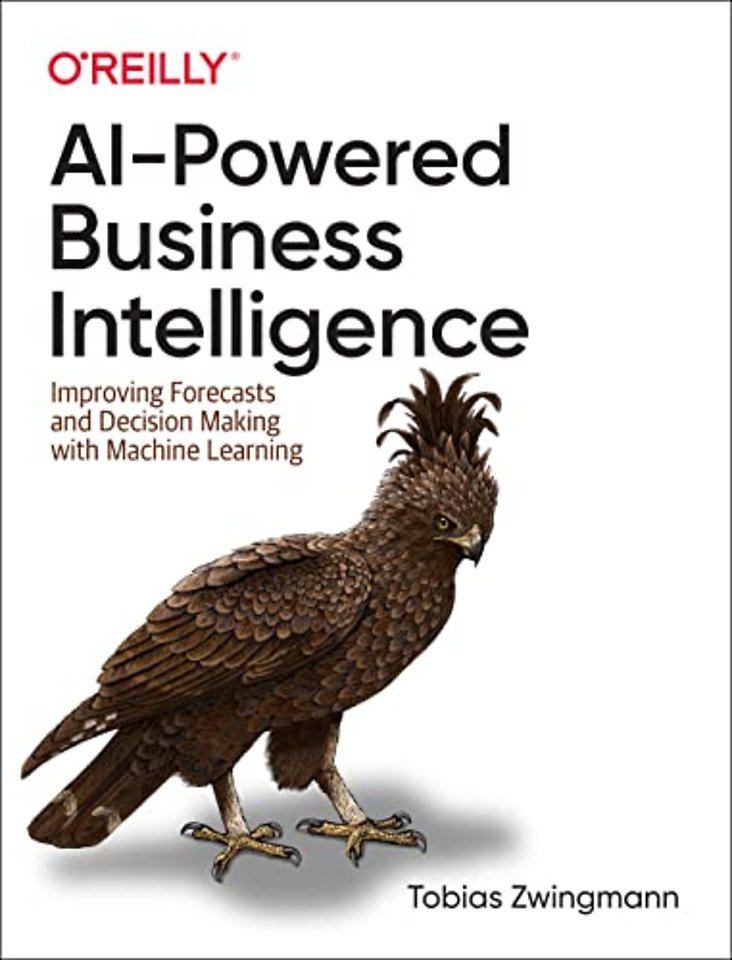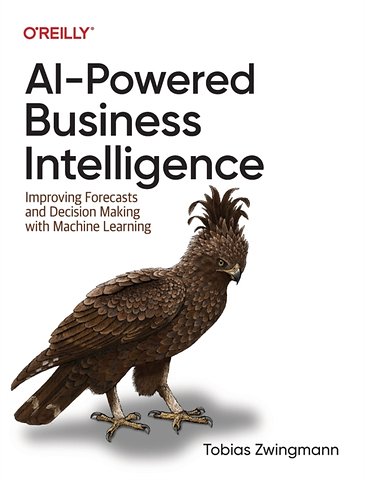AI–Powered Business Intelligence
Improving Forecasts and Decision Making with Machine Learning
Paperback Engels 2022 1e druk 9781098111472Samenvatting
Use business intelligence to power corporate growth, increase efficiency, and improve corporate decision making. With this practical book featuring hands-on examples in Power BI with basic Python and R code, you'll explore the most relevant AI use cases for BI, including improved forecasting, automated classification, and AI-powered recommendations. And you'll learn how to draw insights from unstructured data sources like text, document, images files.
Author Tobias Zwingmann helps BI professionals, business analysts, and data analytics understand high-impact areas of artificial intelligence. You'll learn how to leverage popular AI-as-a-service and AutoML platforms to ship enterprise-grade proofs of concept without the help of software engineers or data scientists.
- Learn how AI can generate business impact in BI environments
- Use AutoML for automated classification and improved forecasting
- Implement recommendation services to support decision-making
- Draw insights from text data at scale with NLP services
- Extract information from documents and images with computer vision services
- Build interactive user frontends for AI-powered dashboard prototypes
- Implement an end-to-end case study for building an AI-powered customer analytics dashboard
Specificaties
Lezersrecensies
Inhoudsopgave
Who Should Read This Book
Microsoft Power BI and Azure
Learning Objectives
Navigating This Book
Conventions Used in This Book
Using Code Examples
O’Reilly Online Learning
How to Contact Us
Acknowledgments
1. Creating Business Value with AI
How AI Is Changing the BI Landscape
Common AI Use Cases for BI
Automation and Ease of Use
Better Forecasting and Predictions
Leveraging Unstructured Data
Getting an Intuition for AI and Machine Learning
Mapping AI Use Case Ideas to Business Impact
Summary
2. From BI to Decision Intelligence: Assessing Feasibility for AI Projects
Putting Data First
Assessing Data Readiness with the 4V Framework
Combining 4Vs to Assess Data Readiness
Choosing to Make or Buy AI Services
AI as a Service
Platform as a Service
Infrastructure as a Service
End-to-End Ownership
Basic Architectures of AI Systems
User Layer
Data Layer
Analysis Layer
Ethical Considerations
Creating a Prioritized Use Case Roadmap
Mix Champions and Quick Wins
Identify Common Data Sources
Build a Compelling Vision
Summary
3. Machine Learning Fundamentals
The Supervised Machine Learning Process
Step 1: Collect Historical Data
Step 2: Identify Features and Labels
Step 3: Split Your Data into Training and Test Sets
Step 4: Use Algorithms to Find the Best Model
Step 5: Evaluate the Final Model
Step 6: Deploy
Step 7: Perform Maintenance
Popular Machine Learning Algorithms
Linear Regression
Decision Trees
Ensemble Learning Methods
Deep Learning
Natural Language Processing
Computer Vision
Reinforcement Learning
Machine Learning Model Evaluation
Evaluating Regression Models
Evaluating Classification Models
Evaluating Multiclassification Models
Common Pitfalls of Machine Learning
Pitfall 1: Using Machine Learning When You Don’t Need It
Pitfall 2: Being Too Greedy
Pitfall 3: Building Overly Complex Models
Pitfall 4: Not Stopping When You Have Enough Data
Pitfall 5: Falling for the Curse of Dimensionality
Pitfall 6: Ignoring Outliers
Pitfall 7: Taking Cloud Infrastructure for Granted
Summary
4. Prototyping
What Is a Prototype, and Why Is It Important?
Prototyping in Business Intelligence
The AI Prototyping Toolkit for This Book
Working with Microsoft Azure
Sign Up for Microsoft Azure
Create an Azure Machine Learning Studio Workspace
Create an Azure Compute Resource
Create Azure Blob Storage
Working with Microsoft Power BI
Summary
5. AI-Powered Descriptive Analytics
Use Case: Querying Data with Natural Language
Problem Statement
Solution Overview
Power BI Walk-Through
Use Case: Summarizing Data with Natural Language
Problem Statement
Solution Overview
Power BI Walk-Through
Summary
6. AI-Powered Diagnostic Analytics
Use Case: Automated Insights
Problem Statement
Solution Overview
Power BI Walk-Through
Summary
7. AI-Powered Predictive Analytics
Prerequisites
About the Dataset
Use Case: Automating Classification Tasks
Problem Statement
Solution Overview
Model Training with Microsoft Azure Walk-Through
What Is an AutoML Job?
Evaluating the AutoML Outputs
Model Deployment with Microsoft Azure Walk-Through
Getting Model Predictions with Python or R
Model Inference with Power BI Walk-Through
Building the AI-Powered Dashboard in Power BI
Use Case: Improving KPI Prediction
Problem Statement
Solution Overview
Model Training with Microsoft Azure Walk-Through
Model Deployment with Microsoft Azure Walk-Through
Getting Model Predictions with Python or R
Model Inference with Power BI Walk-Through
Building the AI-Powered Dashboard in Power BI
Use Case: Automating Anomaly Detection
Problem Statement
Solution Overview
Enabling AI Service on Microsoft Azure Walk-Through
Getting Model Predictions with Python or R
Model Inference with Power BI Walk-Through
Building the AI-Powered Dashboard in Power BI
Summary
8. AI-Powered Prescriptive Analytics
Use Case: Next Best Action Recommendation
Problem Statement
Solution Overview
Setting Up the AI Service
How Reinforcement Learning Works with the Personalizer Service
Setting Up Azure Notebooks
Simulating User Interactions
Running the Simulation with Python
Evaluate Model Performance in Azure Portal
Model Inference with Power BI Walk-Through
Building the AI-Powered Dashboard in Power BI
Summary
9. Leveraging Unstructured Data with AI
Use Case: Getting Insights from Text Data
Problem Statement
Solution Overview
Setting Up the AI Service
Setting Up the Data Pipeline
Model Inference with Power BI Walk-Through
Building the AI-Powered Dashboard in Power BI
Use Case: Parsing Documents with AI
Problem Statement
Solution Overview
Setting Up the AI Service
Setting Up the Data Pipeline
Model Inference with Power BI Walk-Through
Building the AI-Powered Dashboard in Power BI
Use Case: Counting Objects in Images
Problem Statement
Solution Overview
Setting Up the AI Service
Setting Up the Data Pipeline
Model Inference with Power BI Walk-Through
Building the AI-Powered Dashboard in Power BI
Summary
10. Bringing It All Together: Building an AI-Powered Customer Analytics Dashboard
Problem Statement
Solution Overview
Preparing the Datasets
Allocating a Compute Resource
Building the ML Workflow
Adding Sentiment Data to the Workflow
Deploying the Workflow for Inference
Building the AI-Powered Dashboard in Power BI
Anomaly Detection
Predictive Analytics
AI-Powered Descriptive Analytics
Unstructured Data
Summary
11. Taking the Next Steps: From Prototype to Production
Discovery Versus Delivery
Success Criteria for AI Product Delivery
People
Processes
Data
Technology
MLOps
Get Started by Delivering Complete Increments
Conclusion
Index
About the Author
Anderen die dit boek kochten, kochten ook
Rubrieken
- advisering
- algemeen management
- coaching en trainen
- communicatie en media
- economie
- financieel management
- inkoop en logistiek
- internet en social media
- it-management / ict
- juridisch
- leiderschap
- marketing
- mens en maatschappij
- non-profit
- ondernemen
- organisatiekunde
- personal finance
- personeelsmanagement
- persoonlijke effectiviteit
- projectmanagement
- psychologie
- reclame en verkoop
- strategisch management
- verandermanagement
- werk en loopbaan







